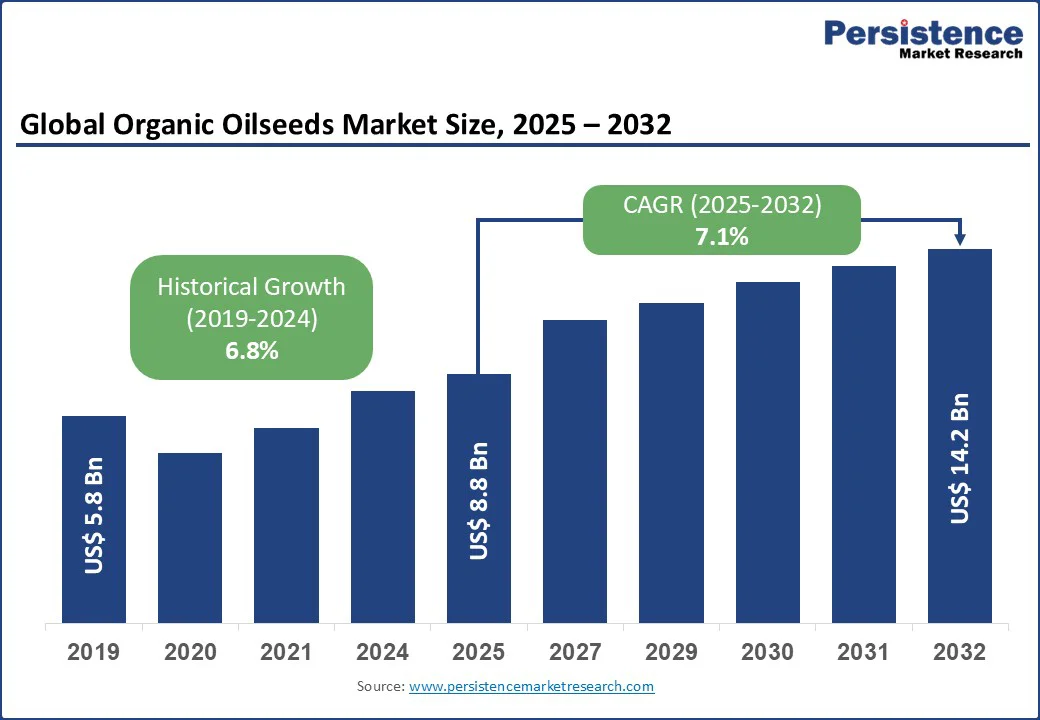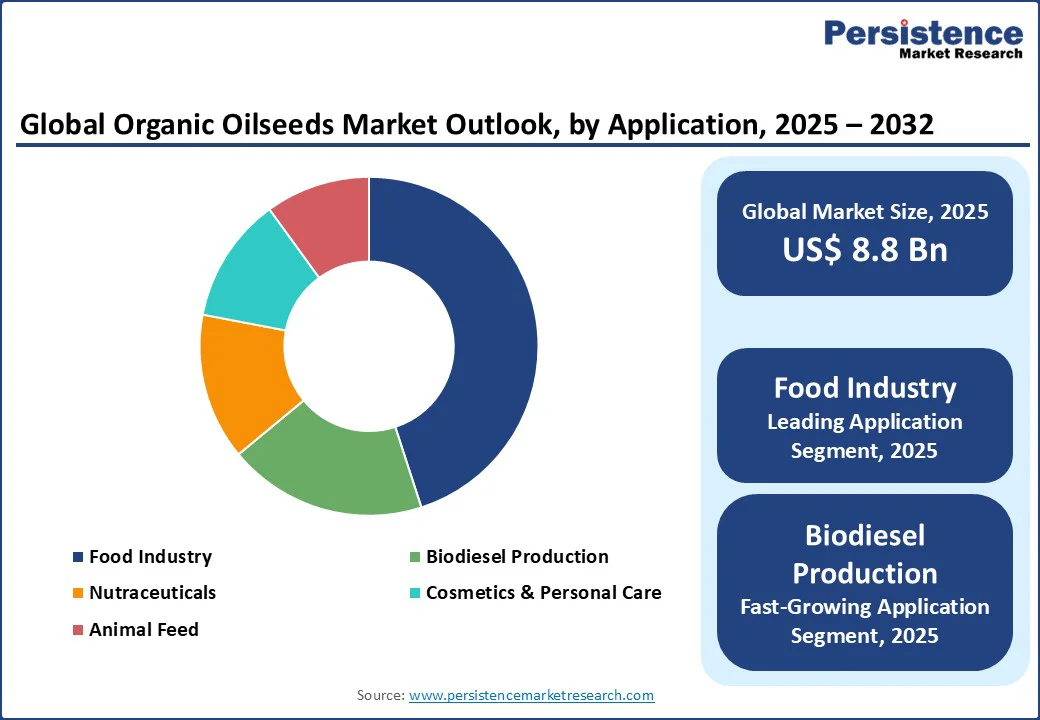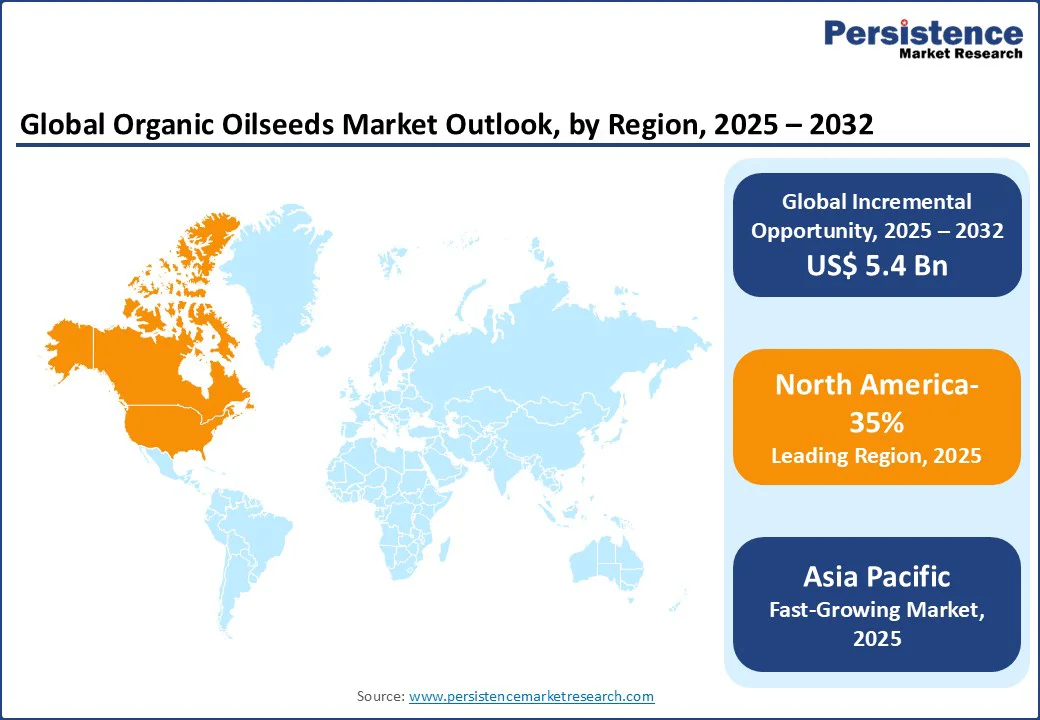ID: PMRREP11257| 187 Pages | 24 Sep 2025 | Format: PDF, Excel, PPT* | Food and Beverages

The global organic oilseeds market size is likely to be valued at US$8.8 Bn in 2025 and US$14.2 Bn by 2032, growing at a CAGR of 7.1% during the forecast period from 2025 to 2032. Rising consumer preference for organic and sustainably produced products and health-conscious buyers with growing demand for chemical-free, non-GMO oilseeds for food, encourages growth of organic oilseeds.
Key Industry Highlights:

| Key Insights | Details |
|---|---|
|
Organic Oilseeds Market Size (2025E) |
US$8.8 Bn |
|
Market Value Forecast (2032F) |
US$14.2 Bn |
|
Projected Growth (CAGR 2025 to 2032) |
7.1% |
|
Historical Market Growth (CAGR 2019 to 2024) |
6.8% |
Growing consumer demand for organic and sustainable products is a key driver of the organic oilseeds market. Consumers are increasingly focusing on healthier diets and eco-friendly choices, leading to a preference for foods produced without synthetic chemicals, genetically modified organisms, or harmful fertilizers. This shift has strengthened demand for oilseeds such as organic soybean, sunflower, and sesame, where buyers are willing to pay premium prices for certified organic and sustainably sourced products. For instance, under the National Programme for Organic Production (NPOP) led by the Agricultural and Processed Food Products Export Development Authority (APEDA), over four million hectares of land in India have been certified for organic farming, including significant areas for oilseeds, highlighting how consumer-driven demand is translating into large-scale adoption.
Government initiatives further reinforce this market expansion. The Mission Organic Value Chain Development for North Eastern Region (MOVCD-NER) has supported thousands of farmers in states such as Sikkim and Assam to adopt organic oilseed cultivation, offering certification, input support, and market linkages. These measures align consumer preferences with institutional support, creating a robust growth pathway for the organic oilseeds sector.
High production costs and supply chain challenges remain significant restraints in the growth of the organic oilseeds market. Organic farming practices require more labor-intensive methods, strict compliance with certification standards, and higher input costs for organic seeds, bio-fertilizers, and natural pest control. Additionally, yields from organic oilseeds are generally lower compared to conventional farming, which raises the overall cost of production and makes organic oilseeds less price-competitive in mass markets.
Supply chain inefficiencies further add to the challenge as organic oilseeds must be segregated from conventional produce at every stage to maintain certification integrity. Limited infrastructure for storage, processing, and distribution of organic products, along with gaps in logistics and market access, often leads to higher operational costs and reduced profitability for producers.
The organic oilseeds market is witnessing strong opportunities from expanding applications in biodiesel and nutraceuticals. Rising concerns over fossil fuel dependence and greenhouse gas emissions are driving demand for cleaner, renewable energy sources. Organic oilseeds such as soybean, rapeseed, and sunflower serve as sustainable feedstocks for biodiesel production, appealing to both governments and industries committed to reducing carbon footprints. The growing emphasis on eco-friendly fuels offers a profitable avenue for organic oilseed producers to tap into expanding biofuel markets worldwide.
In parallel, the nutraceutical industry is creating significant demand for organic oilseeds due to their rich nutritional profile. Flaxseed, chia, and sesame are valued for their high content of omega-3 fatty acids, antioxidants, and proteins, making them ideal for supplements, functional foods, and health products. As consumer preference shifts toward natural, plant-based nutrition, the incorporation of organic oilseeds into nutraceutical formulations is expected to accelerate, opening new growth prospects for the sector.
Soybeans are projected to dominate with a 40% share in 2025, owing to their extensive use in food, feed, and industrial applications. Rich in protein and oil content, organic soybeans are a preferred choice for producing cooking oil, dairy alternatives, and animal feed. Their adaptability to large-scale cultivation and strong global demand, particularly from health-conscious consumers and plant-based food industries, further cements their leading position in the industry.
Pumpkin seeds, on the other hand, are emerging as the fastest-growing segment due to their nutritional richness and rising popularity in the health and wellness industry. Known for their high levels of magnesium, zinc, and antioxidants, organic pumpkin seeds are increasingly used in snacks, bakery, and nutraceuticals, fueling rapid demand growth.
Cold-pressed oil extraction is expected to dominate in 2025 with a 50% share, driven by rising consumer preference for minimally processed, nutrient-rich oils. This method retains the natural flavor, aroma, and nutritional value of oilseeds such as soybean, sunflower, and sesame, making it highly popular in the premium health and wellness segment. The clean-label trend and demand for chemical-free processing further strengthen the position of cold-pressed oils in both domestic and international markets.
In contrast, solvent-extracted oils are anticipated to be the fastest-growing category, supported by their efficiency in large-scale production and cost-effectiveness. Although less popular among health-conscious consumers, advancements in refining technologies and increasing industrial applications are expanding their acceptance, boosting growth in this segment.
The food industry is projected to lead in 2025 with a 45% share, supported by rising demand for healthier cooking oils, plant-based protein ingredients, and organic snacks. Soybeans, sunflower, and sesame seeds are widely utilized in oils, dairy alternatives, bakery, and processed foods, catering to the growing health-conscious consumer base. The clean-label movement and preference for organic certifications further enhance the role of oilseeds in food applications, consolidating the industry’s leading position.
Biodiesel production, however, is expected to be the fastest-growing application segment as governments and industries focus on renewable energy solutions. Organic soybean and rapeseed oils are increasingly being used as sustainable feedstocks for biodiesel, aligning with global initiatives to reduce carbon emissions and fossil fuel dependency.

North America is expected to grow significantly in 2025 with a leading share, driven by strong consumer demand for organic and non-GMO products, well-established certification systems, and advanced farming practices. The region benefits from a high level of health awareness, robust retail distribution networks, and growing adoption of plant-based diets, which fuel demand for organic soybean, sunflower, and flaxseed. Additionally, supportive government policies promoting organic farming and renewable energy, coupled with significant investments in biodiesel and nutraceutical industries, strengthen North America’s leading position in the global market.
Europe is likely to witness attractive growth in the organic oilseeds market, supported by strict regulatory standards, strong consumer preference for organic and sustainable products, and a well-developed retail network for organic food. Countries such as Germany, France, and the UK are at the forefront of organic consumption, driving demand for oilseeds such as sunflower, rapeseed, and pumpkin seeds in food, nutraceutical, and cosmetic applications. The European Union’s Common Agricultural Policy (CAP) and initiatives under the European Green Deal further promote organic farming practices, ensuring steady growth. With the rising adoption of plant-based diets and sustainable energy solutions, Europe continues to be a key regional contributor.
Asia Pacific is expected to be the fastest-growing market for organic oilseeds, registering a high CAGR during the forecast period. Rapidly increasing health awareness, rising disposable incomes, and shifting consumer preferences toward organic and sustainable foods are driving demand across countries such as India, China, and Japan. Additionally, government initiatives supporting organic farming, such as subsidies, certification programs, and technical assistance, are encouraging farmers to adopt organic oilseed cultivation. The growing food processing, nutraceutical, and biodiesel industries in the region further amplify demand, positioning Asia Pacific as a high-growth market with significant opportunities for domestic producers and international investors.

The global organic oilseeds market is characterized by intense competition and a focus on product innovation, quality, and sustainability. Companies are investing in expanding organic cultivation, enhancing supply chain efficiency, and obtaining certifications to meet growing consumer demand. Strategic initiatives such as partnerships, mergers, and distribution network expansion are common to strengthen market presence. Additionally, players are increasingly emphasizing research and development to introduce high-yield, pest-resistant organic varieties, ensuring a competitive edge in both domestic and international markets.
The organic oilseeds market is projected to reach US$8.8 Bn in 2025, driven by demand for organic food and biofuels.
Rising health consciousness, regulatory support for organic farming, and demand for sustainable products fuel market growth.
The organic oilseeds market will grow from US$8.8 bn in 2025 to US$14.2 bn by 2032, with a CAGR of 7.1%.
Expansion in biodiesel production and nutraceuticals, particularly in emerging markets, drives growth opportunities.
Leading players include Archer Daniels Midland, Cargill, Bunge, Bayer, Limagrain, Monsanto, Cootamundra Oilseeds, Burrus Seed, Gansu Dunhuang Seed, and Land O’Lakes.
| Report Attribute | Details |
|---|---|
|
Historical Data/Actuals |
2019 - 2024 |
|
Forecast Period |
2025 - 2032 |
|
Market Analysis |
Value: US$ Bn, Volume: As Applicable |
|
Geographical Coverage |
|
|
Segmental Coverage |
|
|
Competitive Analysis |
|
|
Report Highlights |
|
By Seeds Type
By Extraction Method
By Application
By Region
Delivery Timelines
For more information on this report and its delivery timelines please get in touch with our sales team.
About Author